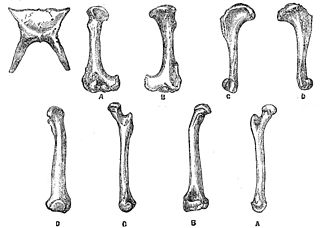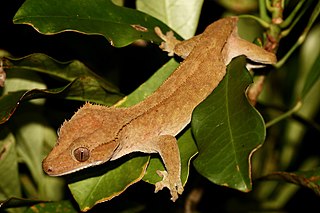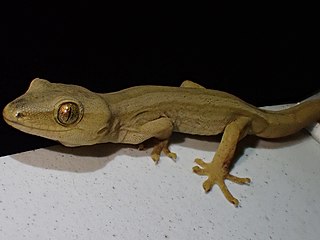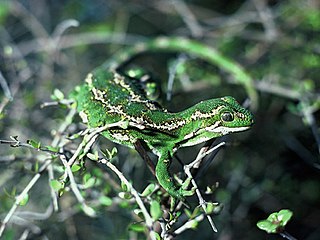
The Rodrigues giant day gecko is an extinct species of day gecko. It lived on the island of Rodrigues and surrounding islands and typically dwelt on trees. The Rodrigues giant day gecko fed on insects and nectar, and, unlike most other day geckos, was apparently nocturnal in habit.

Naultinus is a genus of geckos that are endemic to New Zealand. On account of their striking colouration, species in the genus Naultinus are commonly known as green geckos. There are nine described species in the genus. Species in the genus share a number of traits that set them apart as quite different from the rest of the world's two thousand odd gecko species, which are generally brown in colour, ovivaparous, short-lived and nocturnal. In contrast, Naultinus are green, ovovivaparous, live up to 30 years or more and are strictly diurnal. New Zealand has a temperate, maritime climate, and in terms of distribution Naultinus is one of the southernmost gecko genera in the world — some species live in habitats in the South Island which receive regular snowfall in winter. Animals in this genus possess several physiological and behavioural adaptations to cope with these periods of low temperatures and adverse weather.

The crested gecko or eyelash gecko is a species of gecko native to southern New Caledonia (France). In 1866, the crested gecko was described by French zoologist Alphonse Guichenot. This species was thought to be extinct until it was rediscovered in 1994 during an expedition led by Robert Seipp. Along with several other New Caledonian gecko species, it is being considered for protected status by the Convention on the International Trade in Endangered Species of Wild Flora and Fauna.

Rhacodactylus leachianus, commonly known as the New Caledonian giant gecko, Leach's giant gecko, leachianus gecko, or simply Leachie, is the largest living species of gecko and a member of the family Diplodactylidae. It is native to most of New Caledonia.

Duvaucel's gecko is a species of lizard in the family Diplodactylidae. The species is endemic to New Zealand.

Gigarcanum delcourti, formerly Hoplodactylus delcourti, is an extinct species of gecko in the family Diplodactylidae. It is the largest known of all geckos, with a snout-to-vent length (SVL) of 37 cm (14.6 in) and an overall length of at least 60 cm (23.6 in). It is only known from a single taxidermied specimen collected in the 19th century that was rediscovered unlabelled in a museum in France. The origin of the specimen was undocumented. While originally suggested to have been from New Zealand and the kawekaweau of Māori oral tradition, DNA evidence from the specimen suggests that it originates from New Caledonia.

The gold-striped gecko, gold-stripe gecko, or golden sticky-toed gecko is a species of gecko in the family Diplodactylidae. It is endemic to New Zealand, and is only found in the Taranaki region and Mana Island. The holotype is in the collection of the Museum of New Zealand Te Papa Tongarewa.

The black-eyed gecko, also known commonly as Whitaker's sticky-toed gecko, is a species of lizard in the family Diplodactylidae. An alpine gecko species, discovered in 1970, it inhabits high-altitude mountains in three areas of the South Island of New Zealand. It is the highest-altitude lizard species in New Zealand, living up to 2,200 m (7,200 ft) above sea level.

The harlequin gecko, formerly Hoplodactylus rakiurae, is a species of gecko, a lizard in the family Diplodactylidae. The species is endemic to Stewart Island/Rakiura in the far south of New Zealand, where it was discovered in 1969. In terms of distribution it is one of the southernmost gecko species in the world.

The Stephen's Island gecko, also known commonly as the Cook Strait striped gecko, Stephen's sticky-toed gecko, and the striped gecko, is a species of gecko in the genus Toropuku in the family Diplodactylidae. The species is endemic to New Zealand.

The jewelled gecko is a threatened species of lizard in the family Diplodactylidae. The species is endemic to the South Island of New Zealand.

The West Coast green gecko is a species of the family Gekkonidae (gecko).

Woodworthia maculata, also known as the New Zealand common gecko or Raukawa gecko, is a species in the family Diplodactylidae. The specific name maculata means "speckled".

The Diplodactylidae are a family in the suborder Gekkota (geckos), with over 150 species in 25 genera. These geckos occur in Australia, New Zealand, and New Caledonia. Diplodactylids are the most ecologically diverse and widespread family of geckos in both Australia and New Caledonia, and are the only family of geckos found in New Zealand. Three diplodactylid genera have recently been split into multiple new genera.

The Canterbury gecko is a gecko found in the South Island of New Zealand. It is also known by the Māori names Waitaha gecko and Moko-pāpā, and as the brown gecko. It had previously been placed in a different genus and called Hoplodactylus brunneus, but further study split the genus Hoplodactylus into six genera, with some groups close to the former Hoplodactylus maculatus "Canterbury" being assigned to the new genus Woodworthia.

Pygopodoidea is a gecko superfamily and the only taxon in the gekkotan subclade Pygopodomorpha. The clade includes three Australasian families: Diplodactylidae, Carphodactylidae, and Pygopodidae. Traditional gekkotan systematics had considered Diplodactylidae and Carphodactylidae as subfamilies of the family Gekkonidae, but recent molecular work have placed Pygopodidae within Gekkonidae making it paraphyletic. These analyses have shown support of Pygopodidae and Carphodactylidae being sister taxa, with Diplodactylidae occupying a basal position in Pygopodoidea.
The Waitomo Caves Discovery Centre is a museum located in the town of Waitomo in the North Island of New Zealand. The museum is also referred to as the Waitomo Caves Discovery Centre, the Waitomo Museum of Caves and the Waitomo Education Centre.
Hoplodactylus tohu, the Tohu gecko, is a species of lizard of the family Diplodactylidae. The lizard is found in the Marlborough Sounds / Cook Strait area of New Zealand.















